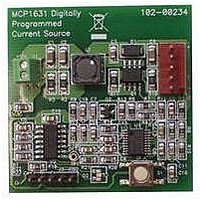MCP1631RD-MCC1 Microchip Technology, MCP1631RD-MCC1 Datasheet - Page 230

MCP1631RD-MCC1
Manufacturer Part Number
MCP1631RD-MCC1
Description
REFERENCE DESIGN FOR MCP1631HV
Manufacturer
Microchip Technology
Type
Battery Managementr
Datasheets
1.MCP1631VHVT-330EST.pdf
(34 pages)
2.MCP1631HV-330EST.pdf
(54 pages)
3.MCP1631RD-MCC2.pdf
(20 pages)
4.MCP1631RD-MCC2.pdf
(328 pages)
5.MCP1631RD-MCC1.pdf
(28 pages)
Specifications of MCP1631RD-MCC1
Main Purpose
Power Management, Battery Charger
Embedded
Yes, MCU, 8-Bit
Utilized Ic / Part
MCP1631HV, PIC16F883
Primary Attributes
1 ~ 2 Cell- Li-Ion, 1 ~ 4 Cell- NiCd/NiMH
Secondary Attributes
Status LEDs
Supported Devices
MCP1631HV, PIC16F883 Device Type
Tool / Board Applications
Power Management-Battery Management
Development Tool Type
Reference Design
Input Voltage
5.5 V to 16 V
Product
Power Management Modules
Mcu Supported Families
MCP1631HV/PIC16F883 Family
Silicon Manufacturer
Microchip
Silicon Core Number
MCP1631HV
Kit Application Type
Reference Design
Application Sub Type
Battery Charger
Kit Contents
Board Only
Lead Free Status / RoHS Status
Lead free / RoHS Compliant
For Use With/related Products
MCP1631HV, PIC16F883
Lead Free Status / RoHS Status
Lead free / RoHS Compliant
- MCP1631VHVT-330EST PDF datasheet
- MCP1631HV-330EST PDF datasheet #2
- MCP1631RD-MCC2 PDF datasheet #3
- MCP1631RD-MCC2 PDF datasheet #4
- MCP1631RD-MCC1 PDF datasheet #5
- Current page: 230 of 328
- Download datasheet (6Mb)
PIC16F882/883/884/886/887
FIGURE 14-11:
DS41291F-page 228
*
External
Connector
Signals
Data I/O
Isolation devices (as required)
CLK
+5V
V
0V
PP
*
To Normal
Connections
To Normal
Connections
TYPICAL IN-CIRCUIT
SERIAL
PROGRAMMING™
CONNECTION
*
*
*
V
V
RE3/MCLR/V
RB6
RB7
PIC16F882/883/
DD
SS
884/886/887
PP
14.10 Low-Voltage (Single-Supply) ICSP
The LVP bit of the Configuration Word enables
low-voltage ICSP programming. This mode allows the
microcontroller to be programmed via ICSP using a
V
means that V
can instead be left at the normal operating voltage. In
this mode, the RB3/PGM pin is dedicated to the
programming function and ceases to be a general
purpose I/O pin. During programming, V
the MCLR pin. To enter Programming mode, V
be applied to the RB3/PGM provided the LVP bit is set.
The LVP bit defaults to on (‘1’) from the factory.
If Low-Voltage Programming mode is not used, the LVP
bit can be programmed to a ‘0’ and RB3/PGM becomes
a digital I/O pin. However, the LVP bit may only be
programmed when programming is entered with V
on MCLR. The LVP bit can only be charged when using
high voltage on MCLR.
It should be noted, that once the LVP bit is programmed
to ‘0’, only the High-Voltage Programming mode is
available and only High-Voltage Programming mode
can be used to program the device.
When using low-voltage ICSP, the part must be
supplied at 4.5V to 5.5V if a bulk erase will be executed.
This includes reprogramming of the code-protect bits
from an on state to an off state. For all other cases of
low-voltage ICSP, the part may be programmed at the
normal operating voltage. This means calibration
values, unique user IDs or user code can be
reprogrammed or added.
DD
Note 1: The High-Voltage Programming mode is
source in the operating voltage range. This only
2: While in Low-Voltage ICSP mode, the
3: When using Low-Voltage ICSP Program-
4: RB3 should not be allowed to float if LVP
5: LVP mode is enabled by default on all
Programming
always available, regardless of the state
of the LVP bit, by applying V
MCLR pin.
RB3 pin can no longer be used as a
general purpose I/O pin.
ming (LVP) and the pull-ups on PORTB
are enabled, bit 3 in the TRISB register
must be cleared to disable the pull-up on
RB3 and ensure the proper operation of
the device.
is enabled. An external pull-down device
should be used to default the device to
normal operating mode. If RB3 floats
high, the PIC16F882/883/884/886/887
device will enter Programming mode.
devices shipped from Microchip. It can be
disabled by clearing the LVP bit in the
CONFIG register.
PP
does not have to be brought to V
© 2009 Microchip Technology Inc.
DD
is applied to
IHH
DD
to the
IHH
must
but
IHH
Related parts for MCP1631RD-MCC1
Image
Part Number
Description
Manufacturer
Datasheet
Request
R

Part Number:
Description:
REFERENCE DESIGN MCP1631HV
Manufacturer:
Microchip Technology
Datasheet:

Part Number:
Description:
REF DES BATT CHARG OR LED DRIVER
Manufacturer:
Microchip Technology
Datasheet:

Part Number:
Description:
Manufacturer:
Microchip Technology Inc.
Datasheet:

Part Number:
Description:
Manufacturer:
Microchip Technology Inc.
Datasheet:

Part Number:
Description:
Manufacturer:
Microchip Technology Inc.
Datasheet:

Part Number:
Description:
Manufacturer:
Microchip Technology Inc.
Datasheet:

Part Number:
Description:
Manufacturer:
Microchip Technology Inc.
Datasheet:

Part Number:
Description:
Manufacturer:
Microchip Technology Inc.
Datasheet:

Part Number:
Description:
Manufacturer:
Microchip Technology Inc.
Datasheet:

Part Number:
Description:
Manufacturer:
Microchip Technology Inc.
Datasheet:










